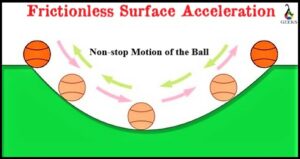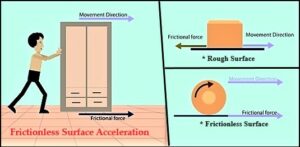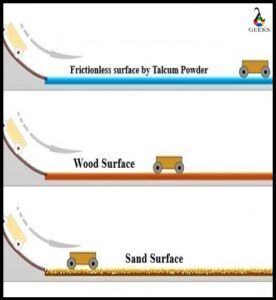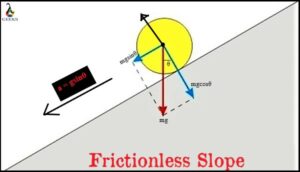Frictionless surface acceleration represents how the body moves on the frictionless surface with constant velocity.
When the surface is frictionless, no net force on the moving stops its motion. Hence, the body continues to travel with the same velocity. That’s the reason we interpret “frictionless” as “moving without stopping”. The event of no acceleration is summoned as ‘frictionless surface acceleration’.
When two bodies accelerate to slide with each other, they experience the opposing forces at their point of contact of surfaces that deaccelerate them. One of the opposing forces is a normal force that acts perpendicular to the surface, and the other is a friction force that acts tangent to the surface. These opposing forces provide energy to the body’s internal particles that change their interatomic distances, leading to deaccelerating the body’s motion.
The bodies with frictionless surfaces do not deform since their interatomic distance remains the same during their motion. On such a frictionless surface, the normal force acting upward passes through the center. Consequently, the moving body experience zero torque or zero forces about its center. That’s why the net forces cannot deaccelerate or accelerate the body, and the body’s rotational and translational motion cannot be changed.

Henceforth, if the body moves on a frictional surface, it will move forever without acceleration or change in its motion.

Frictionless Surface Vs Rough Surface (credit: shutterstock)
Read more about Inclined Plane Acceleration.
What is the Acceleration on a Frictionless Surface?
The acceleration on a frictionless surface is the perpetual motion of the body in the absence of reaction force.
The acceleration on any surface is the measure of the force exerted by the surface. The friction force, which is supposed to stop the motion, is eliminated on the frictionless surface. Since the net forces act on the body become zero, acceleration in frictionless surfaces is also zero.

Acceleration on Different Surfaces
As Newton’s first law of motion states – the applied muscular force makes the body to move in the direction of force with equal speed. As Newton’s second law of motion states – the body is accelerated, equivalent to the applied muscular force.
F= ma ……………(*)
Unlike the first law, the second law also explains the situation in which the net force on an object is not zero. That means the various forces produce different accelerations of an object.
As Newtown’s third law of motion states – there is a reaction force for the applied force exerted by the surface of the other body when friction between two surfaces occurs.
“The frictional force is directly proportional to the normal force. “
Ffric = μ FN
Whereas, μ is coefficient of friction.
When we make the surface smooth in different ways, we reduce the coefficient of friction μ of the surface that depends on the surface’s roughness. On such a frictionless surface, only the normal force acts on the body but along its motion when the body starts sliding. No reaction forces can resist the body’s motion. That’s why the body moves in the horizontal direction or along the path of applied force with constant velocity on frictionless surfaces.
As per Newton’s law of motion, the body will move with constant motion permanently, except we employ any small quantity of force to it. Usually, the frictional force opposes the constant motion. But on a frictionless surface, however, there is no force to withstand the motion. That’s the body will travel on and on.
Read more about Newton’s Laws of Motion.
How does a Frictionless Surface affect Acceleration?
The frictional surface affects the acceleration of the body by eliminating the friction force that opposes the motion.
When the body slides on a rough surface, it deaccelerated quickly to rest due to friction force. But if we make the surface smoother to eliminate the friction force, the body slides farther. That’s how frictional surface affects the acceleration of the body to slide in a straight path endlessly.
Suppose we apply push force on a block that is resting on a table. First, the block will slide on the table surface due to push force, but it comes to a halt after some time due to friction force from the table. The various types of friction force – such as sliding friction and rolling friction, oppose the body’s motion and stop the body from slipping.

Frictionless Surface affect Acceleration
If we make the table surface smoothen, the time elapsed between the block start to slide, and the rest will increase. Suppose the table surface becomes frictionless such that its friction becomes almost negligible. In that case, the block proceeds to slide along a straight pathway without requiring any force to keep going for the greater distance.
The frictionless surface does not allow acceleration to any object unless we accelerate them with external unbalanced force. e.g., dropping on. Any other forces employed parallel to a frictionless surface would make the body to slip as friction force is absent. The moving body cannot travel any sideways movement on a frictionless surface.
A frictionless plane is not existing in real life. Notwithstanding its nonexistence, a frictionless plane has significant value in the design of roadways, motors, and engines, etc.
Read more about Sliding Friction.
How to find the Acceleration of an Object on a Frictionless Slope?
The acceleration on a frictionless slope is determined by resolving the gravitational force on the object into two components.
On frictionless slope, an object moves parallel to the plane. The normal force and gravitational perpendicular component cancel each other as both forces are in the same direction. Hence, only the gravitational parallel component accelerates an object in frictionless slope.
Any object accelerates on a frictionless surface of an inclined plane. We can either measure its acceleration or figure it by determining the weight component descending the slope and implementing Newton’s second law of motion.
When an object slides on a frictionless slope, the normal force N is exerted on it by a surface, and gravitational force is exerted by the earth, which is the object’s weight. The normal force is perpendicular, and the gravitational force is vertically downward to the surface.
Since the slope is frictionless, an object accelerates along the slope and is further restrained parallel to its surface as it progresses. Therefore, the net force, such as normal force N and y-component of gravitational force (mgcosθ), perpendicular to the slope, must be zero. As a result, only the x-component of gravitational force (mgsinθ) is parallel to the slope – accelerating an object on a frictionless surface.
F = mgsinθ …………..(1)
Comparing equation (*) and (1), we get
ma = mgsinθ
a = gsinθ ………………(2)
Whereas θ is the incline angle and g is the acceleration due to gravity or acceleration produced by the gravitational force.
On a frictionless surface, the force is required to accelerate an object is mgsinθ, which will accelerate equally to gsinθ.

Acceleration in Frictionless Slope
Checking the limiting events in frictionless surfaces, we can also notice that
- No force along a horizontal frictionless surface as the inclined angle θ is zero.
- Force along a vertical frictional surface is mg as inclined angle θ = 90°.
Read more about Types of Forces.
What is the Acceleration of an Object sliding down a Frictionless Ramp?
The acceleration of an object sliding down a frictionless ramp is smaller than the acceleration due to gravity value.
The acceleration of an object on the frictionless surface of an inclined ramp is equal to gsinθ. The ramp has possible angles 0< θ<90°, giving values 0<sinθ<1. Therefore, the acceleration of an object sliding down a frictionless ramp should be 0<gsinθ<g.
As we explained earlier, the acceleration on a frictionless surface is gsinθ.
In other words, on a frictionless surface, the mass of an object cancels out, which predicts that any object, regardless of size and mass, will slide down on a frictionless inclined surface at the same acceleration gsinθ.
Since g= 9.8 m/s2 and θ = 30° for an inclined ramp.
Substituting above values into equation (2), we get
a = 9.8 sin 30°
a = 9.8 * ½
a = 4.9 m/s2
Any object is typically accelerated with 4.9 m/s2 on a frictionless surface of an inclined plane.
If an object starts from rest and then travel a distance x, moving down the frictionless ramp in time t; the one of the kinematic equation of motion x=(1/2)at2 becomes, x=(1/2)gsinθt2
We can find out the time will be taken by an object to reach the bottom of the ramp.

Note that when an inclined ramp angle is 90°, an object will fall freely downward.
Read more about Kinematic Equations of Motion.
Also Read:
- Centripetal force vs centripetal acceleration
- How to find mass without acceleration
- How to find acceleration with two velocities
- How to find acceleration rate
- How to find acceleration with position time graph
- How acceleration differs from speed
- How to find acceleration calculus
- Factors affecting acceleration
- How to find tension force with acceleration
- How to find acceleration with angle and coefficient of kinetic friction 2

Hello, I’m Manish Naik completed my MSc Physics with Solid-State Electronics as a specialization. I have three years of experience in Article Writing on Physics subject. Writing, which aimed to provide accurate information to all readers, from beginners and experts.
In my leisure time, I love to spend my time in nature or visiting historical places.
Looking forward to connecting you through LinkedIn –